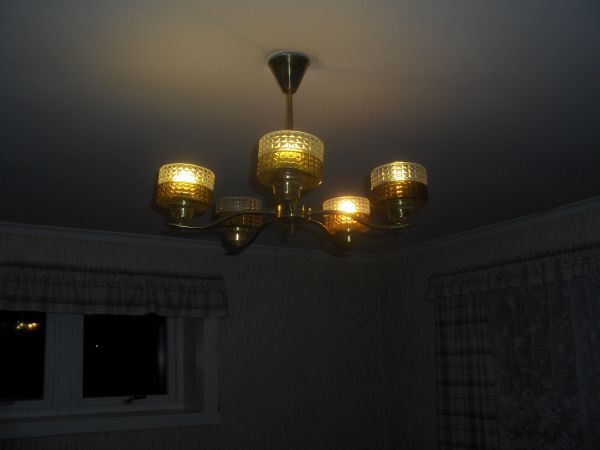
Two of these are different.
Now for the reason why I was in the electronics supermarket in the first place. You see, the last few weeks the light bulbs in this house have started dying off at an alarming rate. See the picture above? In it, there is only one of the original light bulbs left, the one to the right of the dead one, the one with the yellower light. You know what? Between me taking that picture earlier this week and now, it went out too. On the other hand, I have replaced the one that is lacking in the picture.
What is even more disturbing than them going out merely days apart, is that they did so one after another with the clock, always the one to the side of the newest bulb, always the same side. It is like a conspiracy.  Is it a mysterious message from beyond the universe? If so, I don’t understand it, so I’ll just ignore it. Write clearer messages if it is important, Beyond The Universe!
Lamps like these are actually ideal for the new LED age. You see, one big difference between LED and incandescent bulbs is how they handle high output. This is more or less the default for the old type of bulbs, although technology has made available small, weak bulbs for flashlights etc eventually. The first ones, however, were big. With LED (light emitting diodes) it is the other way around. The first were the tiny on/off lights on electronic equipment, barely visible in daylight. New technology has increased the output, as well as the energy consumption.
The largest direct replacement LED bulbs I could find were 7W, which corresponds roughly to 40W incandescent. There will probably be stronger ones eventually, but it won’t be easy. Basically you make stronger bulbs by cramming in more diodes and using blue light, which is converted to white by the coating. Â But weaker lights are cheaper to make and more energy efficient. You can retain the higher efficiency, but at the cost of changing the shape of the bulb to get more diodes, for instance in a long rod in the middle of the bulb. But if you want to keep the same shape and size, there are limits currently to how strong they can be.
That’s where lamps with multiple weak bulbs come in handy. They put out plenty of light, but they don’t do so all at one point. 3W LED bulbs easily replace a 25W bulb of similar size and shape, shave almost nine tenths of the electricity cost, and last for 30 years. Or that’s what they say – the technology has not actually been around for that long. Actually there is no reason why they should not last for a century, but unfortunately I am unlikely to find out.
You may have heard about how incandescent bulbs were made with planned obsolescence through a conspiracy among bulb makers. There is a long and seemingly reasonable video freely available on the Net revealing the conspiracy, which stretches decades back. Reality is slightly different. Not that there wasn’t a conspiracy, but it was a conspiracy of standardization rather than simply exploitation.
You see, with incandescent bulbs, longevity comes at a cost. Two costs, actually. For bulbs to last longer, you need a slightly thicker filament (the glowing wire part). The thinner it is, the more fragile. But the thicker it is, the less efficient. You get less light per watt with a thicker, sturdier filament. This isn’t rocket science: The copper wire that leads to your lamp does not shine in the dark and does not melt off the plastic insulation. Because it is much thicker and offers less resistance, it does not even grow hot. The thinner and the more resistance, the hotter and brighter. So you can have incandescent bulbs with longer life, but a higher utility bill or less brightness. The companies standardized on a certain proportion, the 1000 hours bulb. It may not have been incidental that it also got them more sales, but why would they have less sales when the utility companies reaped the difference?
In any case, with LED bulbs having a lifespan of 15, 20 or even 30 years, there is no economic incentive to planned obsolescence at all. By then, the current leadership of the company is likely to be gone, the shareholders will also have changed, even many of the employees. There is simply no point in adding the electronics to keep track of the age of the bulb and make it go poof after 20 years. So it is more likely it will still shine brightly when you and I, dear reader, have both gone to our eternal home and moss covers our headstone, if any.
But if, as I sincerely hope, my eternal home waits until well after I have left this particular house, I’ll probably bring my LED bulbs along, or at least as many as there are lamps in the next domicile. Not that I have any in the sight right now. It’s up to the landlord now – the rent is up for revision at the turn of the year, and if he is too greedy, I’m out. With my LED bulbs, Light willing.
